The Forage Plantation Program between Desertification Mitigation and Livestock Feeding: An Economic Analysis
Abstract
:1. Introduction
2. Methodology
2.1. Steppe Area and Formations
2.2. Data Sources and Evaluation Methods
- The mean annual net income (MANI) was used to evaluate the financial performance of the program. It is the ratio between the total net income, as cash flow sum, and the lifecycle of the investment [21]. MANI was calculated using Equation (1).
- The net present value (NPV) was widely used to evaluate the program’s economic feasibility [21,22,23,24,25,26,27,28]. It presents the cash inflows subtracted by the cash outflows linked to the investment over an observed period. A positive NPV indicates an economically feasible program [29,30]. NPV was calculated according to Equation (2).where i is years, n is the lifecycle of investment, p is the interest rate, CFi is the total cash flow in year i, and Ei is the cost or expense in year i.
- The Annuity (A) was used to represent the payment of invested funds in a fixed income stream for the life period of the investment. [21] indicated that A could replace the actual cash flow without changing its NPV (Equation (3)).
3. Results and Discussion
3.1. Returns
3.2. Forage Units
3.3. Economic Analysis of Forage Plantation Program
3.3.1. Cost of One Hectare
- 01 worker = 45 plants/day;
- 01 Hectare = 800 plants = 18 working days;
- 01 permanent job equivalent = 240 days.
3.3.2. Economic Parameters
Mean Annual Net Income, Net Present Value, and Annuity
Profitability Index (PI)
Payback Period (PP)
4. Conclusions
Author Contributions
Funding
Institutional Review Board Statement
Informed Consent Statement
Data Availability Statement
Acknowledgments
Conflicts of Interest
Appendix A
| Wilaya | Number of Proposed Perimeters | Number of Rented Perimeters | Total (Hectare) | Proposed (Hectare) | Rented (Hectare) | % Rented | Returns (Million DZD) | Forage Units (Million FUs) |
|---|---|---|---|---|---|---|---|---|
| DJELFA | 44 | 39 | 12,736 | 12,736 | 7797 | 61 | 15,594 | 5.068 |
| TIARET | 2 | 2 | 650 | 650 | 559 | 86 | 1.118 | 0.363 |
| M’SILA | 53 | 18 | 9974 | 9216 | 1932 | 21 | 3.864 | 1.256 |
| SETIF | 18 | 9 | 2238 | 2038 | 402 | 20 | 0.804 | 0.261 |
| TEBESSA | 52 | 27 | 11,388 | 11,388 | 1718 | 15 | 3.436 | 1.117 |
| OUM EL BOUAGHI | 13 | 13 | 3750 | 2843 | 1080 | 38 | 2.160 | 0.702 |
| KHENCHELA | 27 | 3 | 4789 | 4789 | 150 | 3 | 0.300 | 0.098 |
| SOUK-AHRAS | 10 | 4 | 3540 | 3540 | 210 | 6 | 0.420 | 0.137 |
| BATNA | 6 | 2 | 3000 | 3000 | 125 | 4 | 0.250 | 0.0813 |
| SAIDA | 5 | 5 | 2000 | 980 | 980 | 100 | 1.960 | 0.637 |
| SIDI BEL ABBES | 3 | 3 | 650 | 650 | 600 | 92 | 1.200 | 0.390 |
| Total | 233 | 125 | 54,715 | 51,830 | 15,553 | 30 | 31.106 | 10,109 |
| 1994–2001 | 2002–2004 | 2005–2006 | 2007–2010 | 2011–2013 | 2014–2021 | |
|---|---|---|---|---|---|---|
| Mean Annual Net Income (MANI) | 6676.78 | 10,541.71 | 11,983.34 | 11,983.34 | 11,983.34 | 11,983.34 |
| Net Present Value (NPV) | 69,118.91 | 103,054.13 | 110,404.78 | 104,291.06 | 86,935.48 | 62,127.58 |
| Annuity (A) of NPV | 8745.05 | 13,038.59 | 13,968.61 | 13,195.09 | 10,999.23 | 7860.49 |
| Profitability Index (PI) | 4.91 | 4.03 | 3.43 | 3.03 | 2.26 | 1.66 |
| Payback Period (PP) (year) | 3 | 4 | 4 | 5 | 6 | 8 |
| Sheep Breeders | Total Number of Sheep Heads | |
|---|---|---|
| 2020 | 860 | 330,308 |
| 2019 | 3705 | 1,477,328 |
| 2018 | 1717 | 249,042 |
| 2017 | 2027 | 930,683 |
References
- Nedjraoui, D. Country Pasture/Forage Resource Profiles—Algeria; Food and Agriculture Organization of the United Nations (FAO): Rome, Italy, 2006; Available online: https://ees.kuleuven.be/klimos/toolkit/documents/648_Algeria.pdf (accessed on 19 March 2022).
- Boukhobza, M. L’Agropastoralisme Traditionnel en Algérie: De l’Ordre Tribal au Désordre Colonial; OPU: Ben Aknoun, Algeria, 1982; p. 458. [Google Scholar]
- Slimani, H.; Aidoud, A.; Roze, F. 30 Years of protection and monitoring of a steppic rangeland undergoing desertification. J. Arid. Environ. 2010, 74, 685–691. [Google Scholar] [CrossRef]
- Bahlouli, F.Z.; Djabeur, A.; Kefifa, A.; Arfi, F.; Kaid-harche, M. Degradation of Western Algerian Steppes Lands: Monitoring and Assessment. Ind. J. Ecol. 2018, 45, 235–243. [Google Scholar]
- Hadjoune, H.; Kihal, O.; Kaci, A.; Belhouadjeb, F.A. Quel avenir pour la filière huile d’olive fraichement introduite dans une zone steppique? Cas de la région de M’Sila. N. Medit. A Mediterr. J. Econ. Agric. Environ. 2021, 20, 2. [Google Scholar] [CrossRef]
- Boukerker, H.; Boumedjene, M.R.; Doghbage, A.; Belhouadjeb, F.A.; Kherifi, W.; Hecini, L.; Bekiri, F. State of Pastoral Resources in the Algerian Steppe Regions: Main Factors of Degradation and Definition of Preservation and Rehabilitation Actions. Livest. Res. Rural. Develop. 2021, 33, 140. [Google Scholar]
- Yerou, H.; Belgharbi, B.; Homrani, A.; Miloudi, A. 2022. Impact de la restauration par mis en défens sur les potentialités pastorales d’un parcours steppique à dominance d’Artemisia herba alba dans l’Algérie occidentale. Livest. Res. Rural. Dev. 2022, 34, 8. [Google Scholar]
- Boussaada, D.; Yerou, H.; Benabdelli, K.; Djelailia, S. Evaluation des potentialités pastorales des parcours steppiques algériennes cas de M’sila (Algérie). Livest. Res. Rural. Dev. 2022, 34, 4. [Google Scholar]
- Djeddaoui, F.; Chadli, M.; Gloaguen, R. Desertification Susceptibility Mapping Using Logistic Regression Analysis in the Djelfa Area, Algeria. Remote Sens. 2017, 9, 1031. [Google Scholar] [CrossRef] [Green Version]
- Slimani, H.; Aidoud, A. Desertification in the Maghreb: A case study of an Algerian high-plain steppe. In Environmental Challenges in the Mediterranean 2000–2050, Marquina, A., Ed.; Kluwer Academic Publishers: Dordrecht, The Netherlands, 2004; pp. 93–108. [Google Scholar] [CrossRef]
- Meddi, H.; Meddi, M. Study of the persistence of drought in seven Algerian plains using Markov chains (1930–2003). Mail. Knowl. 2009, 9, 39–48. (In French) [Google Scholar]
- Meddi, H.; Meddi, M. Variability of annual rainfall in northwestern Algeria. Sci. Planet. Changes/Drought 2009, 20, 57–65. (In French) [Google Scholar]
- Benabadji, N.; Aboura, R.; Benchouk, F. La régression des steppes méditerranéennes: Le cas d’un faciès à Lygeum spartum L. d’Oranie (Algérie). Ecol. Mediterr. 2009, 35, 75–90. [Google Scholar] [CrossRef]
- Aidoud, A.; Le Floc’h, E.; Le Houérou, H.N. Les steppes arides du nord de l’Afrique. Sécheresse 2006, 17, 19–30. [Google Scholar]
- Hasnaoui, O.; Meziane, H.; Borsali, A.H.; Bouazza, M. Evaluation of Characteristics Floristico-Edaphic of the Steppes at Alfa (Stipa tenacissima L.) in the Saida Region (Western Algeria). Open J. Ecol. 2014, 4, 883–891. [Google Scholar] [CrossRef] [Green Version]
- Bureau National d’Études Pour le Développement Rural (BNEDER). Les Potentialités Agropastorales de la Steppe Algérienne: Requêtes Cartographiques, Analyse et Interprétation de l’information Géographique; Bureau National d’Études pour le Développement Rural (BNEDER): Chéraga, Algeria, 2010. [Google Scholar]
- Benaredj, A.; Mederbal, K.; Benabdeli, K. Remontée biologique du parcours steppique à Lygeum spartum après une durée de mise en défens dans la steppe sudoranaise de Naâma (cas de la station de Touadjeur). Mediterr. Epoca II 2010, 21, 10–48. [Google Scholar]
- Djamel, A.; Abdelkrim, B.; Hafidha, B. The Impact of Exclosure on the Rehabilitation of Steppe Vegetation at Naâma Rangelands in Algeria. J. Rangel. Sci. 2022, 12, 2. [Google Scholar] [CrossRef]
- Oubraham, F.; Bedrani, S.; Belhouadjeb, F.A. Does interest rate subsidy really promote the financing of farms? The case of the wilaya of Laghouat in Algeria. Cah. Agric. 2021, 30, 23. [Google Scholar] [CrossRef]
- Moulay, A.; Benabdeli, K.; Morsli, A. 2012 Quel avenir pour la steppe à Alfa dans le Sud-Ouest algérien? Forêt Méditerr. 2012, 33, 277–286. [Google Scholar]
- Schiberna, E.; Borovics, A.; Benke, A. Economic Modelling of Poplar Short Rotation Coppice Plantations in Hungary. Forests 2021, 12, 623. [Google Scholar] [CrossRef]
- Yoomak, S.; Patcharoen, T.; Ngaopitakkul, A. Performance and Economic Evaluation of Solar Rooftop Systems in Different Regions of Thailand. Sustainability 2019, 11, 6647. [Google Scholar] [CrossRef] [Green Version]
- Battisti, F.; Campo, O. A Methodology for Determining the Profitability Index of Real Estate Initiatives Involving Public–Private Partnerships. A Case Study: The Integrated Intervention Programs in Rome. Sustainability 2019, 11, 1371. [Google Scholar] [CrossRef] [Green Version]
- López-Marín, J.; Gálvez, A.; del Amor, F.M.; Brotons, J.M. The Financial Valuation Risk in Pepper Production: The Use of Decoupled Net Present Value. Mathematics 2021, 9, 13. [Google Scholar] [CrossRef]
- Hirigoyen, A.; Acuna, M.; Rachid-Casnati, C.; Franco, J.; Navarro-Cerrillo, R. Use of Optimization Modeling to Assess the Effect of Timber and Carbon Pricing on Harvest Scheduling, Carbon Sequestration, and Net Present Value of Eucalyptus Plantations. Forests 2021, 12, 651. [Google Scholar] [CrossRef]
- Itaka, S. Economic Analysis of Cedar Plantation Management and Mega-Solar Replacement. Forests 2021, 12, 361. [Google Scholar] [CrossRef]
- Olczak, P.; Olek, M.; Matuszewska, D.; Dyczko, A.; Mania, T. Monofacial and Bifacial Micro PV Installation as Element of Energy Transition—The Case of Poland. Energies 2021, 14, 499. [Google Scholar] [CrossRef]
- Hering, T.; Olbrich, M.; Rapp, D. Net present value, duration, and CAPM in light of investment theory: A comment on Kruk. Q. J. Austrian Econ. 2021, 24, 348–359. [Google Scholar] [CrossRef]
- Gallo, A.A. Refresher on Net Present Value; Harvard Business Review: Brighton, MA, USA, 2014. [Google Scholar]
- Abdelhady, S. Performance and cost evaluation of solar dish power plant: Sensitivity analysis of levelized cost of electricity (LCOE) and net present value (NPV). Renew. Energy 2021, 168, 332–342. [Google Scholar] [CrossRef]
- Coppola, A.; Scardera, A.; Amato, M.; Verneau, F. Income Levels and Farm Economic Viability in Italian Farms: An Analysis of FADN Data. Sustainability 2020, 12, 4898. [Google Scholar] [CrossRef]
- Bhandari, S.B. Discounted Payback Period-Some Extensions. J. Bus. Behav. Sci. 1989, 21, 28–38. [Google Scholar]
- Wong, I.L.; Eames, P.C.; Perera, R.S. A review of transparent insulation systems and the evaluation of payback period for building applications. Solar Energy 2007, 81, 1058–1071. [Google Scholar] [CrossRef]
- Mahlia, T.M.I.; Razak, H.A.; Nursahida, M.A. Life cycle cost analysis and payback period of lighting retrofit at the University of Malaya. Renew. Sustain. Energy Rev. 2011, 15, 1125–1132. [Google Scholar] [CrossRef] [Green Version]
- Belhouadjeb, F.A. Stratégies des Eleveurs Ovins en Milieu Steppique et Contraintes du Marché. Ph.D. Thesis, Ecole Nationale Supérieure Agronomique (ENSA), El-Harrach, Algérie, 2017; p. 147. Available online: http://dspace.ensa.dz:8080/jspui/handle/123456789/1953 (accessed on 2 March 2022).
- Belhouadjeb, F.A. Analyse de la Compétitivité de la Filière Ovine Algérienne. Cas des Eleveurs de la Wilaya de Djelfa; Mémoire de Magister; Ecole Nationale Supérieure Agronomique (ENSA): El-Harrach, Algérie, 2009; p. 86. Available online: http://dspace.ensa.dz:8080/jspui/handle/123456789/315 (accessed on 3 March 2022).
- Gamoun, M.; Louhaichi, M. Botanical Composition and Species Diversity of Arid and Desert Rangelands in Tataouine, Tunisia. Land 2021, 10, 313. [Google Scholar] [CrossRef]
- Abaab, A.; Neffati, M.; Sghaier, M.; Khorchani, T.; Nefzaoui, A.; Frija, A.; Jalouali, S.; Ghoudi, Z.E. L’expérience tunisienne en matière du développement des territoires pastoraux: Acquis, enseignements et orientations stratégiques. Revue Rég. Arides 2020, 47, 7–45. [Google Scholar]
- Mahyou, H.; Tychon, B.; Balaghi, R.; Mimouni, J.; Paul, R. Désertification des parcours arides au Maroc. Tropicultura 2010, 28, 107–114. [Google Scholar]
- Naggar, M. Stratégie sylvopastorale et renouveau des pratiques pastorales en forêt au Maroc. Rev. For. Fr. 2018, 70, 487–501. [Google Scholar] [CrossRef] [Green Version]
- Réquier-Desjardins, M.; Jauffret, S.; Khatra, N.B. Chapitre 4-Lutter contre la désertification. In MediTERRA 2009; Presses de Sciences Po: Paris, France, 2009; pp. 137–182. [Google Scholar]
- Al-Bukhari, A.; Hallett, S.; Brewer, T. A review of potential methods for monitoring rangeland degradation in Libya. Pastoralism 2018, 8, 1–14. [Google Scholar] [CrossRef]
- Gebril, A.O.; Saeid, A.G. Importance of pastoral human factor overloading in land desertification: Case studies in northeastern Libya. World Acad. Sci. Eng. Technol. 2012, 6, 10–26. [Google Scholar]
- Zatout, M.M.M. The Roles of Exotic and Native Tree Species in Preventing Desertification and Enhancing Degraded Land Restoration in the North East of Libya. Reciprocal Effects of Environmental Factors and Plantation Forestry on Each Other, Assessed by Observations on Growth and Reproductive Success of Relevant Tree Species, and Environmental Factors Analysed Using Multivariate Statistics. Ph.D. Thesis, University of Bradford, Bradford, UK, 2013. [Google Scholar]
- Ferchichi, A. Les parcours de la Tunisie présaharienne: Potentialités, état de désertification et problématique d’aménagement. Options Medit. 1999, 39, 137–141. [Google Scholar]
- Zaafouri, M.S. Contraintes du Milieu et Réponses de Quelques Espèces Arbustives Exotiques Introduites en Tunisie Présaharienne. Science Changement Planétaires/Sécher. 1993, 4, 201. [Google Scholar]
- Zaafouri, M.S.; Akrimi, N.; Floret, C.; Le Floc’h, E.; Pontannier, R. Les plantations sylvopastorales en Tunisie présaharienne. Sécheresse 1994, 5, 265–275. [Google Scholar]
- Brouri, L. Problématique et perspective de développement de la steppe Algérienne. In Séminaire sur la Conservation et la Valorisation de la Diversité des Ressources Phylogénétiques du Maghrebe; University of Ghardaia: Ghardaia, Algérie, 1996. [Google Scholar]
- Hachmi, A.; EL Alaoui-Faris, F.E.; Acherkouk, M.; Mahyou, H. Parcours arides du Maroc: Restauration par mise en repos, plantations pastorales et conservation de l’eau et du sol. Geo.-Eco.-Trop. 2015, 39, 185–204. [Google Scholar]
- Kaba, A. Etude de l’Impact d’une Plantation Fourragères à Base d’Atriplex (Atriplex halimus & Atriplex canescens) dans la Région de Zâafrane Wilaya de Djelfa; USTHB: Bab Ezzouar, Algeria, 1996. [Google Scholar]
- Siad, R.; Zaidi, S. Effet de l’Introduction de l’Atriplex Canescens dans l’Amélioration et la Réhabilitation des Parcours des Zones Arides, Cas la Plaine d’Ain Oussera; USTHB: Bab Ezzouar, Algeria, 2001. [Google Scholar]
- Mulas, M.; Mulas, G. Potentialités d’Utilisation Stratégique des Plantes des Genres Atriplex et Opuntia dans la Lutte Contre la Désertification; Université des Etudes de Sassari: Sassari, Italy, 2004. [Google Scholar]
- Genin, D.; Khorchani, T.; Hammadi, M. Improving nutritive value of a North African range grass (Stipa tenacissima): Effect of dung ash and urea treatment on digestion by goats. Anim. Feed. Sci. Technol. 2007, 136, 1–10. [Google Scholar] [CrossRef]
- Liu, J.; Dietz, T.; Carpenter, S.R.; Alberti, M. Complexity of coupled human and natural systems. Science 2007, 317, 1513–1516. [Google Scholar] [CrossRef] [PubMed] [Green Version]
- Tu, C.; Suweis, S.; D’Odorico, P. Impact of globalization on the resilience and sustainability of natural resources. Nat. Sustain. 2019, 2, 283–289. [Google Scholar] [CrossRef]
- Ostrom, E. A general framework for analyzing sustainability of social-ecological systems. Science 2009, 325, 419–422. [Google Scholar] [CrossRef] [PubMed]
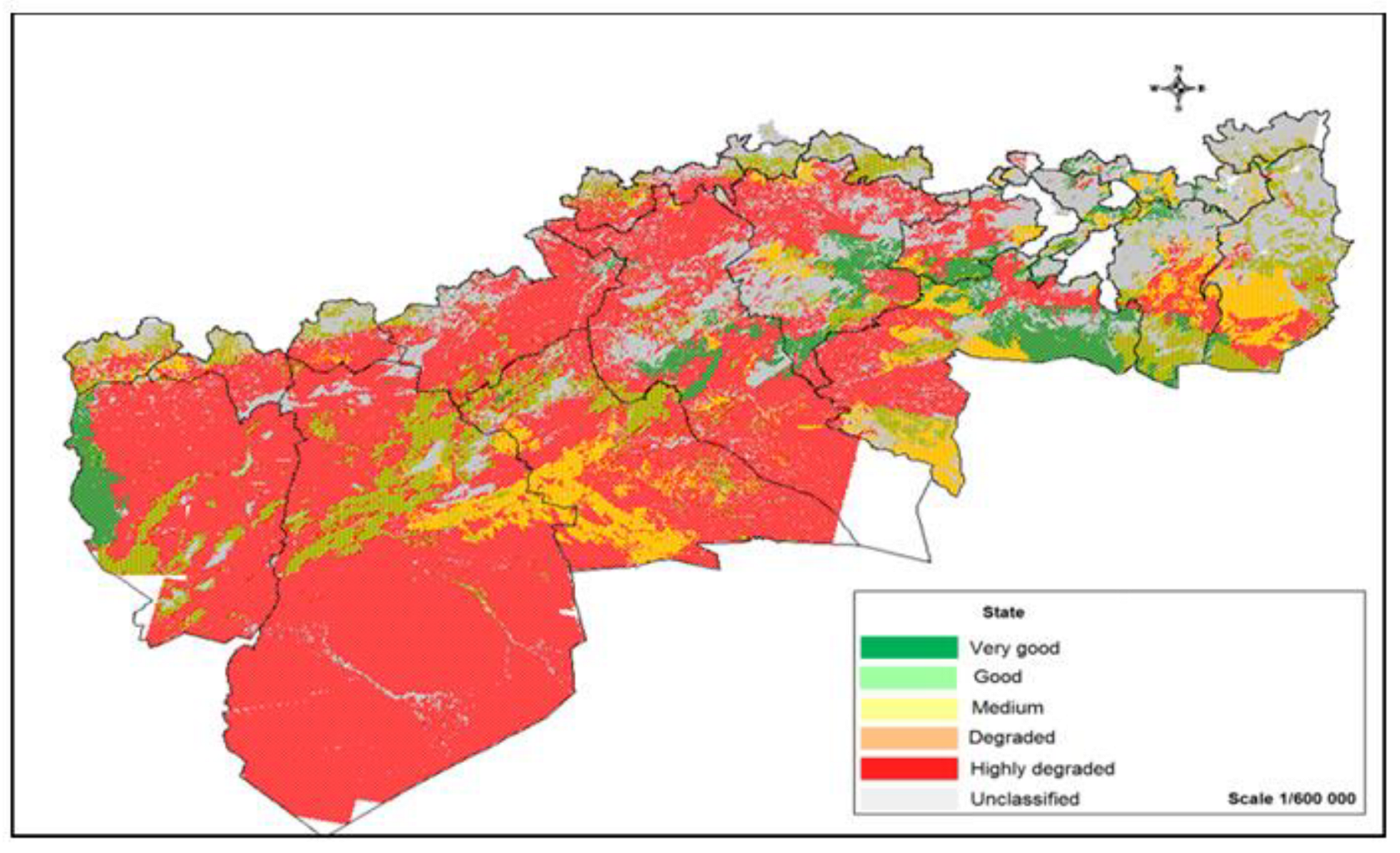





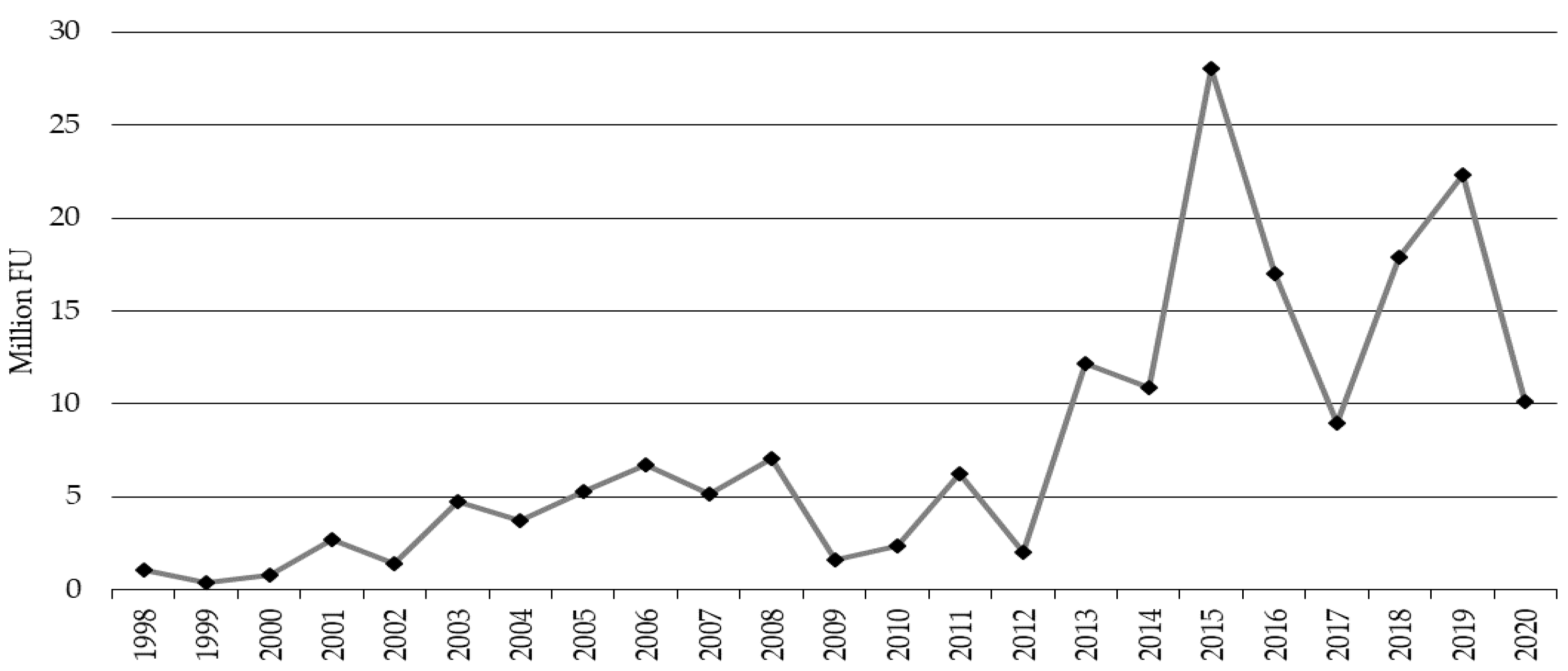

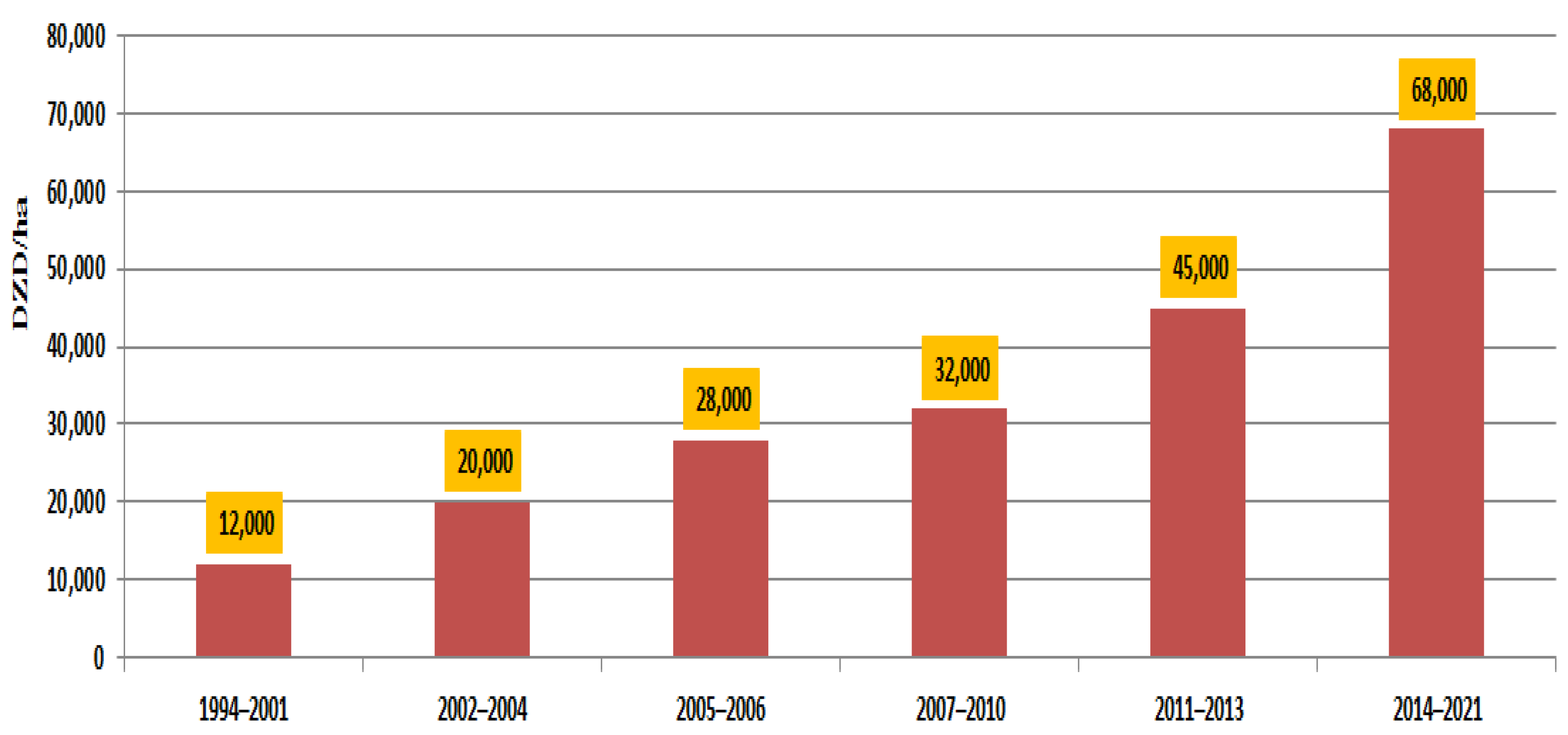

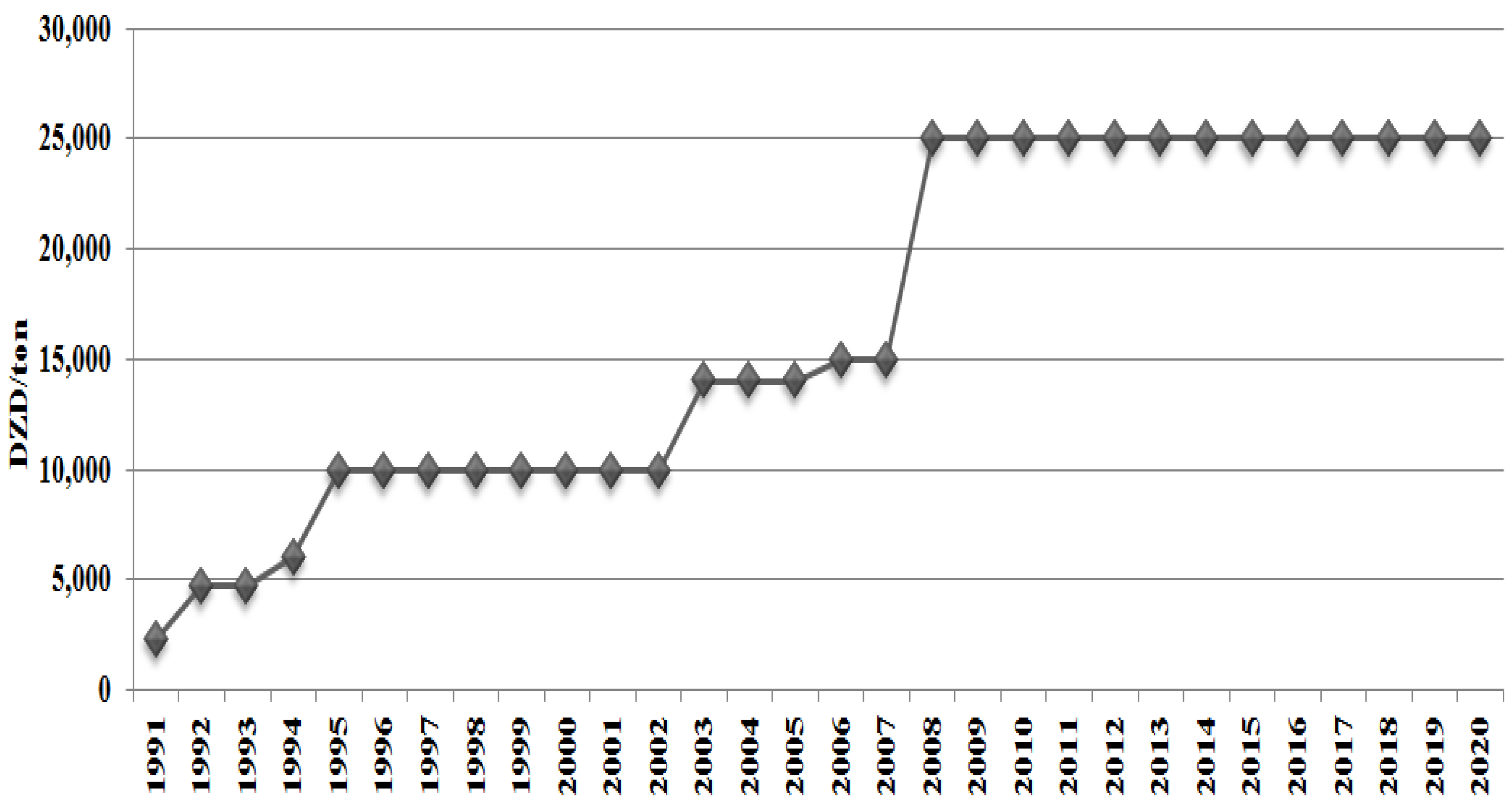

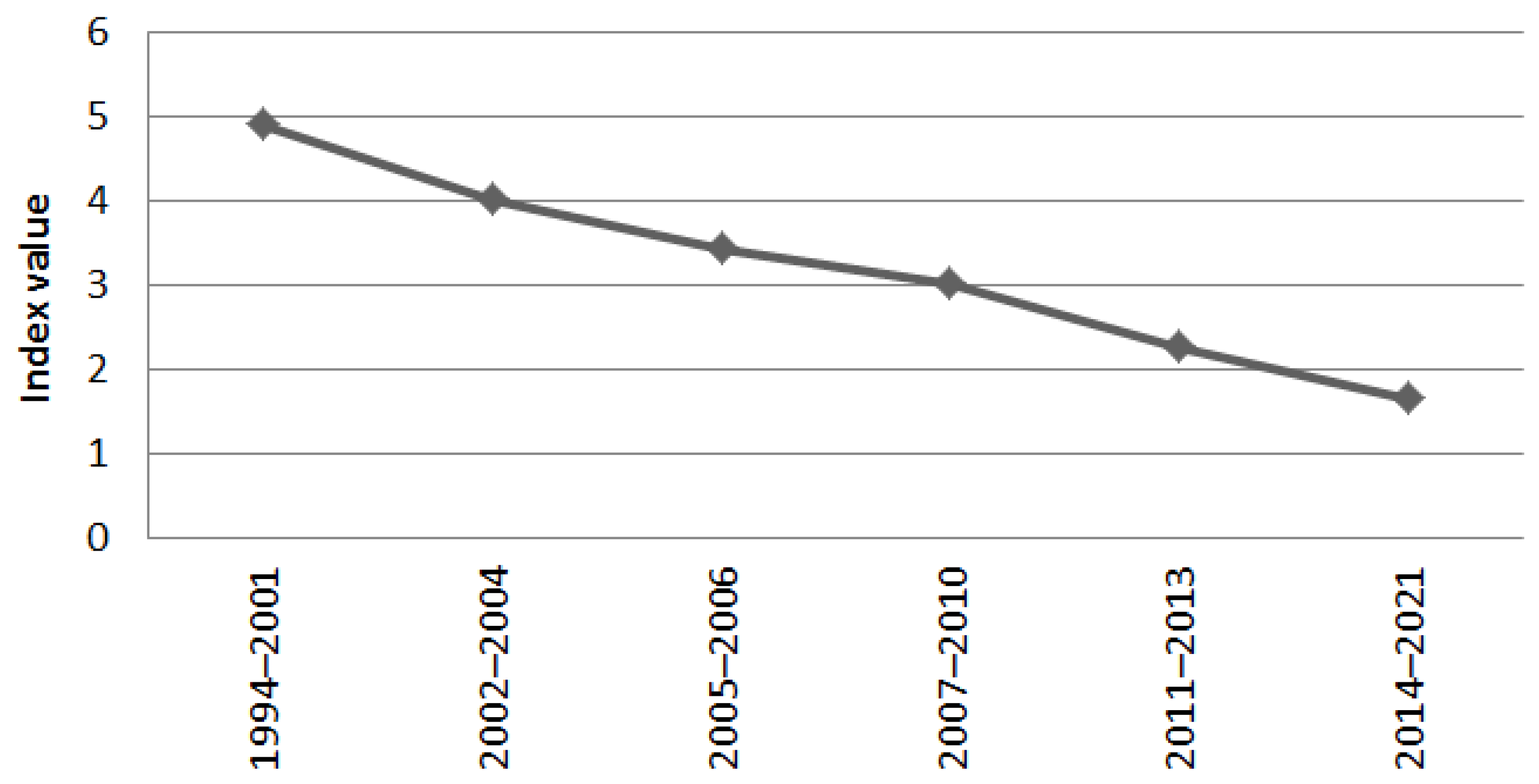

| Area (ha) | Bioclimatic Zones | Grazing Yield | Feeding Value | |
|---|---|---|---|---|
| Alfa (Stipa tenacissima) | 4 million | Wide ecological range from semi-arid to upper arid | 1–1.5 ton/ha DM | 0.3–0.5 FUs/kg DM |
| Artemisia (Artemisia herba-alba) | 3 million | Upper and middle arid 100–300 mm/year | 1 ton/ha DM | 0.65 FUs/kg DM |
| Spartum (Lygeum spartum) | 2 million | Upper and middle arid | 0.3–0.5 ton/ha DM | 0.3–0.4 FUs/kg DM |
| Remt (Arthrophytum scoparium) | NA | Extremely arid (20–200 mm/year) | 0.04–0.08 ton/ha DM | 0.2 FUs/kg DM |
| Items | Costs (DZD/ha) |
|---|---|
| Purchase of forage plants (+transport) | 6400 |
| Purchase of seeds and bags | 1176.47 |
| Soil preparation | 659.21 |
| Boundary stones and delimitation | 196.08 |
| Labor costs | 53,181.36 |
| Technical and administrative supervision | 196.08 |
| Guarding of the forage plantation | 5994.72 |
| Administrative management costs | 196.08 |
| Total | 68,000 |
Publisher’s Note: MDPI stays neutral with regard to jurisdictional claims in published maps and institutional affiliations. |
© 2022 by the authors. Licensee MDPI, Basel, Switzerland. This article is an open access article distributed under the terms and conditions of the Creative Commons Attribution (CC BY) license (https://creativecommons.org/licenses/by/4.0/).
Share and Cite
Belhouadjeb, F.A.; Boumakhleb, A.; Toaiba, A.; Doghbage, A.; Habib, B.; Boukerker, H.; Murgueitio, E.; Soufan, W.; Almadani, M.I.; Daoudi, B.; et al. The Forage Plantation Program between Desertification Mitigation and Livestock Feeding: An Economic Analysis. Land 2022, 11, 948. https://doi.org/10.3390/land11060948
Belhouadjeb FA, Boumakhleb A, Toaiba A, Doghbage A, Habib B, Boukerker H, Murgueitio E, Soufan W, Almadani MI, Daoudi B, et al. The Forage Plantation Program between Desertification Mitigation and Livestock Feeding: An Economic Analysis. Land. 2022; 11(6):948. https://doi.org/10.3390/land11060948
Chicago/Turabian StyleBelhouadjeb, Fathi Abdellatif, Abdallah Boumakhleb, Abdelhalim Toaiba, Abdelghafour Doghbage, Benbader Habib, Hassen Boukerker, Enrique Murgueitio, Walid Soufan, Mohamad Isam Almadani, Belkacem Daoudi, and et al. 2022. "The Forage Plantation Program between Desertification Mitigation and Livestock Feeding: An Economic Analysis" Land 11, no. 6: 948. https://doi.org/10.3390/land11060948
APA StyleBelhouadjeb, F. A., Boumakhleb, A., Toaiba, A., Doghbage, A., Habib, B., Boukerker, H., Murgueitio, E., Soufan, W., Almadani, M. I., Daoudi, B., & Khadoumi, A. (2022). The Forage Plantation Program between Desertification Mitigation and Livestock Feeding: An Economic Analysis. Land, 11(6), 948. https://doi.org/10.3390/land11060948








